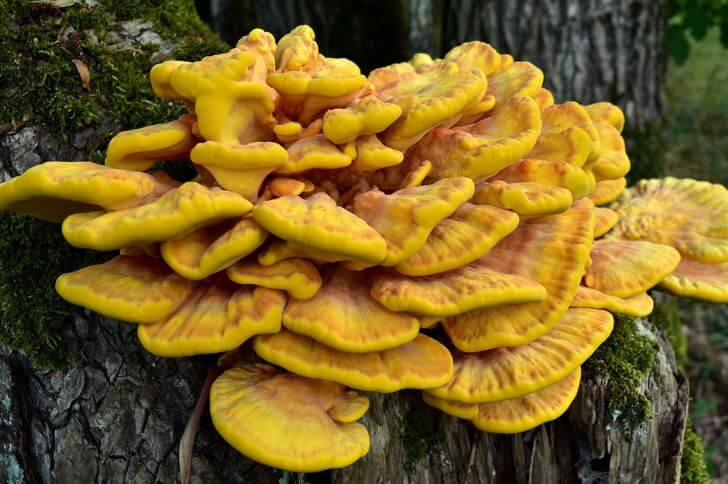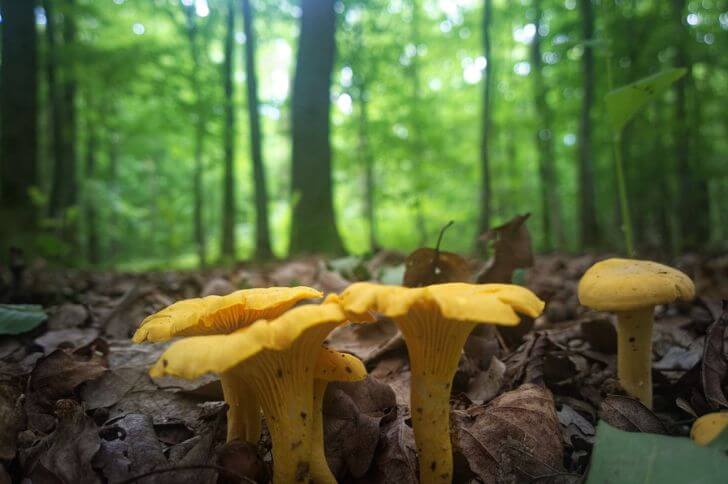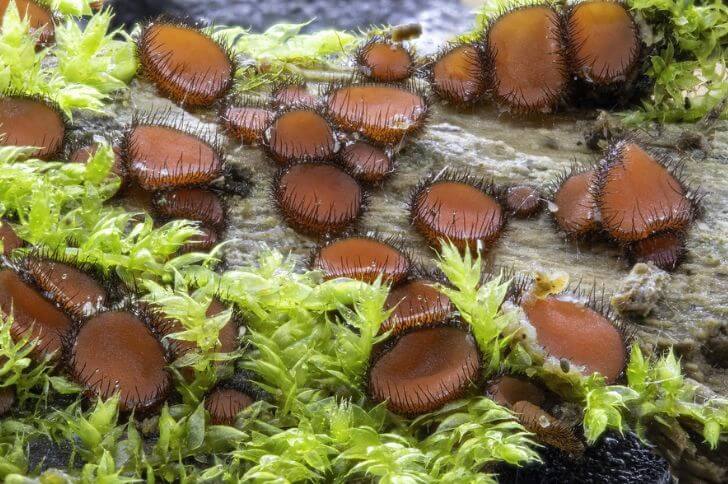Nestled in the lush forests and wetlands of Florida, a vibrant and enchanting world of orange mushrooms awaits discovery. These unique fungi, with their eye-catching hues and intriguing shapes, are a source of fascination for mushroom enthusiasts.
From the radiant chicken of the woods fungus to the striking flame-colored chanterelle, the diverse array of orange mushrooms found in Florida’s ecosystems showcases the rich biodiversity of this sunshine state.
If you live in the sunshine state or are visiting and want to identify the different orange mushrooms of Florida, the curated list below will be of great use to you.
Orange mushrooms in Florida
1. Chicken of the Woods

Chicken of the woods is a fascinating orange species of mushroom that can be found in the forests of Florida.
Its striking orange and yellow hues make it a distinctive sight against the green backdrop of the woodlands.
This vibrant fungus is not only visually captivating but also boasts a unique texture and flavor that has earned it the nickname chicken mushroom. When properly prepared, it can serve as a delectable meat substitute for vegetarians and vegans alike.
This orange mushroom in Florida is saprophytic in nature, meaning it thrives by decomposing dead or decaying wood. This makes it an important player in the ecosystem’s nutrient cycling processes.
Additionally, its ability to grow on live trees makes it an indicator of potential decay within those trees. As such, observing this species could offer valuable insights into the health and vitality of forest ecosystems.
2. Meadow Waxcap (Cuphophyllus pratensis)
Cuphophyllus pratensis, commonly known as the Meadow Waxcap, is an enchanting orange mushroom that adds a vibrant pop of color to the Florida landscape.
Its striking appearance and delicate structure make it a captivating sight for any nature enthusiast wandering through the lush meadows and woodlands of the region.
Despite its alluring beauty, this species also plays a crucial role in maintaining ecosystem health by participating in vital mycorrhizal associations with surrounding plant life.
One of the most fascinating aspects of this orange mushroom is its ephemeral nature. The mushroom’s brief existence means that encountering it in the wild is akin to stumbling upon a rare treasure.
This fleeting quality adds an air of mystery and excitement to any encounter with these vibrant orange fungi, making them all the more precious to those who appreciate the wonder and magic of the natural world.
3. Stereum Complicatum
Stereum complicatum, is another unique orange mushroom species that can be found in the forests of Florida.
Its unique appearance with its wavy, fan-shaped fruiting bodies makes it easily identifiable among other mushrooms.
One of the interesting facts about Stereum complicatum is its ability to grow on dead wood and contribute to the decomposition process, playing an important role in nutrient recycling within forest ecosystems.
What sets it apart is its vibrant orange color, which adds a pop of brightness to the forest floor. This distinctive hue not only makes it visually striking but also serves as a means of attracting the attention of foragers and wildlife, potentially aiding in spore dispersal.
Its presence in Florida’s forests highlights the rich biodiversity of the region and underscores the importance of preserving these ecosystems for future generations to appreciate and study.
4. Velvet-top fungus (Phaeolus schweinitzii)
Native to North America, Phaeolus schweinitzii or the dyer’s polypore or velvet-top fungus, is a captivating orange mushroom species often found in Florida’s lush forests.
Its vibrant color and unique appearance make it a popular subject for nature enthusiasts and photographers alike. Beyond its aesthetic appeal, this species plays an essential role in the ecosystem, forming symbiotic relationships with trees and helping to decompose organic matter.
Despite its striking orange hue, Phaeolus schweinitzii is more than just a visually captivating fungus; it also has historical significance as a natural dye.
Traditional uses of this mushroom have been recorded among indigenous cultures for dyeing textiles and other materials in various shades of yellow and orange.
5. Hapalopilus Croceus
Hapalopilus croceus is a striking sight in Florida’s lush forests. Its vibrant orange caps and distinctive pore surface make it easily identifiable by mushroom enthusiasts and hikers alike.
What sets this species apart is its unique ability to thrive on decaying hardwoods, particularly oak trees, adding a pop of color to the forest floor.
Beyond its aesthetic appeal, this orange fungus offers a deeper connection to the ecosystem through its ecological role and potential health benefits—an intriguing aspect worth exploring during nature walks in Florida’s woodlands.
6. Smooth Chanterelle (Cantharellus Lateritius)

Found in the damp forests of Florida, Cantharellus lateritius is a striking yellow-orange mushroom that captivates with its vibrant color and unique shape.
Its subtle fruity aroma and delicate meaty texture make it a sought-after ingredient for foraging enthusiasts and culinary experts alike.
Despite its enchanting appearance, these orange mushrooms in Florida hold an air of mystery as they thrive amidst the leaf litter and decaying organic matter of its habitat.
Their symbiotic relationship with trees adds to its allure, highlighting the intricate connections within ecosystems that often go unnoticed.
Is the smooth chanterelle edible? Yes, this orange fungus pairs well with various ingredients like parsley.
7. Orange Spindle Coral (Clavulinopsis aurantiocinnabarina)
The vibrant and striking appearance of Clavulinopsis aurantiocinnabarina, commonly known as the orange spindle coral fungus, is a sight to behold in the woodlands of Florida.
This unique mushroom boasts an intense orange hue that stands out against the verdant backdrop of the forest floor. Its delicate, corallike structure adds an element of intrigue and charm to its surroundings, drawing in anyone lucky enough to encounter it.
What makes Clavulinopsis aurantiocinnabarina a particularly captivating species is its association with specific hardwood species such as pine and oak.
8. Persistent Waxcap (Hygrocybe Acutoconica)
Hygrocybe acutoconica, commonly called the persistent waxcap, is a vibrant and eye-catching species of mushroom found in Florida. Its striking orange coloration and distinct conical cap make it a captivating sight for any nature enthusiast.
This elusive fungus can be found growing in wet habitats such as bogs, marshes, and damp woodlands, adding a splash of color to these natural landscapes.
9. Omphalotus subilludens (Jack o’lantern)
The orange jack o’lantern mushroom is an intriguing fungus that can be found in the lush woodlands of Florida. With its vibrant orange hue and bioluminescent properties, this species has captured the attention of mushroom enthusiasts and nature lovers alike.
What makes this particular mushroom even more fascinating is its ability to glow in the dark, creating a mystical and enchanting atmosphere in the forest at night.
Despite its beauty, it’s important to note that Omphalotus subilludens are not suitable for consumption and should be admired from a distance.
This cautionary aspect adds an air of mystery to these mushrooms and emphasizes their unique characteristics. Furthermore, their presence in Florida’s ecosystems serves as a reminder of the diverse and enchanting natural world that surrounds us.
10. Laccaria Trichodermophora
Laccaria trichodermophora is a stunning and elusive mushroom species found in the rich forests of Florida. Its vibrant orange cap and slender stem make it a mesmerizing sight for any mycology enthusiast.
What sets this species apart is its tendency to form mycorrhizal relationships with trees, playing a vital role in nutrient exchange within forest ecosystems. While often overlooked due to its small size, Laccaria trichodermophora is an essential player in the delicate balance of the forest floor.
Interestingly, recent studies have revealed potential medicinal properties associated with Laccaria trichodermophora.
11. Eyelash cup (Scutellinia scutellata)

The bright orange mushrooms found in Florida’s forests may seem straight out of a fairytale, but the Scutellinia scutellata is as real as it gets.
These striking fungi, commonly known as the eyelash cup, can be spotted peeking out from decaying wood or leaf litter. Despite their diminutive size, these tiny cups pack a punch with their vibrant color and unique shape, making them an intriguing find for nature enthusiasts.
One fascinating aspect of these orange mushrooms in Florida is their reproductive strategy. Instead of relying on spores for dispersal like many other fungi, these mushrooms release a liquid containing spores.
This unusual method has captured the interest of mycologists and adds to the allure of this already captivating species. As they stand out against the forest floor in their vivid hue, these dazzling little cups are a testament to nature’s artistry and complexity.
12. Cinnabar Polypore (Pycnoporus cinnabarinus)
The cinnabar polypore is one of the rarest orange fungus in Florida. With its orange fruiting body that measures about 3.5, this bracket fungi is hard to miss.
On the surface, this orange polypore is wrinkled and is initially vibrant red-orange in color, fading to pinkish-orange with age.
Underneath, like most polypore this cinnabar bracket has tubes that have whitish spores. Note the rounded edges.
Is the cinnabar polypore edible? No. The fruiting body is too hard, making it unpalatable.
13. Amanita Persicina (Peach-colored Fly Agaric)
Amanita persicina, commonly called peach-colored fly agaric, is a striking orange fungus that can be found in the forests of Florida. Its color and distinctive appearance make it an easy find for mushroom enthusiasts and hikers alike.
This species is often associated with oak and pine trees, where it forms mycorrhizal relationships, playing a crucial role in the ecosystem.
What makes Amanita persicina so captivating is not just its stunning appearance, but also its potential toxicity. This mushroom contains compounds that can cause severe illness if ingested, making it important for foragers to exercise caution when identifying wild mushrooms.
14. Cantharellus coccolobae
The Cantharellus coccolobae is a strikingly vibrant orange mushroom that can be found throughout the forests of Florida.
Its unique appearance and delicate flavor make it a prized find for avid mushroom foragers and culinary enthusiasts alike. Unlike its close relatives, this particular species has a distinct affinity for growing near coccoloba trees, adding an extra layer of intrigue to its elusive nature.
One fascinating aspect of the Cantharellus coccolobae is its symbiotic relationship with certain tree species in the region. Studies have shown that these mushrooms form mycorrhizal associations with coccoloba trees, exchanging nutrients in a mutually beneficial manner.
Final Thoughts:
The types of orange mushrooms found in Florida are diverse and fascinating. From the bright and striking cinnabar polypore to the delicate and elegant orange spindle coral, these fungi add a pop of color to the Florida landscape.
However, it is important to remember that while some orange mushrooms are edible and even prized for their culinary uses, others are inedible.
Therefore, it is crucial for mushroom enthusiasts to exercise caution and consult with experts before consuming any wild mushrooms.
source:

